Intel Haswell Low Power CPU Review: Core i3-4130T, i5-4570S and i7-4790S Tested
by Ian Cutress on December 11, 2014 10:00 AM EST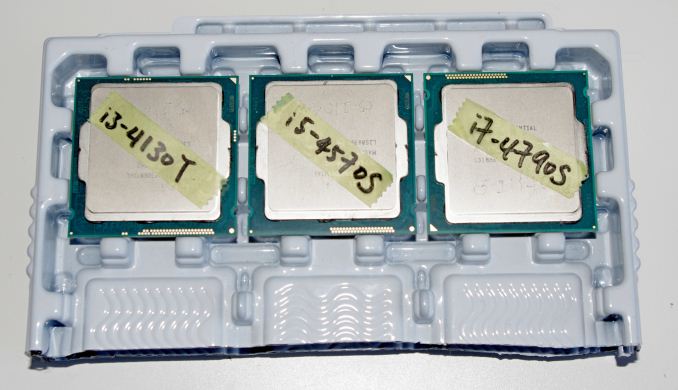
Despite being an integral part of Intel's product stack, reviews of the lower power models are few and far between. For those of us that have no interest in overclocking, the lower power parts can offer similar stock performance to the big boys but at 65W and 35W. Today we are testing three chips available from Newegg at $135, $215 and $315.
Not All CPUs are Alike
While Intel's CPU naming scheme is finally starting to make sense to home system builders, their product stack consists mainly of generic numbers in either Celeron, Pentium, i3, i5 or i7 format unless someone sits down and explains the trend to the individual. These models are clearly defined whereby a bigger number tends to mean more frequency. With this general stack of names, there are sometimes models that come with extra letters. Overclockers already know the K and the X models as having their multiplier unlocked for extra potential, but for other CPUs we have T and S destinations. (Xeons also use the letter L, and mobile chips have H/Y/U.)
Simply put, T is used for 35W/45W models and S is for 65W models. The S models tend to have similar single core performance to their normal cousins, but reach 65W by reducing the multicore frequency when the CPU is loaded. The T models reduce both single core and multicore frequency to hit their 35W or 45W, but tend to be a little more esoteric in their position in the stack.
In general there are two ways to reduce the TDP on a CPU. We can either reduce frequency (easy) or reduce voltage (difficult). Reducing the voltage results in more of a change in power consumption, but the best way to tackle this is when Intel performs its binning process.
When a manufacturer creates a wafer of CPUs, these have to be tested for accuracy of calculations, functions, and the voltage/frequency response. It is this latter characteristic which matters most when determining what product in the stack it should be. The units with the highest frequency for the lowest voltage (on a scale) tend to be reserved for the fastest processors or Xeons. Note that it is not only a single data point being tested, but a whole scale from low frequency to high frequency. The unit has to match an entire line to be sufficient for that designation. Where the low power CPUs come in is that they follow a particular line at a potentially lower voltage range than expected.
There have been reports of the regular branding of CPUs being reduced in frequency and matching the stability of the S/T processors. That is entirely possible, as a unit can be a member of many bins at the same time. At the end of the day, when you purchase a lower power processor, you are essentially guaranteed that level of performance and TDP by the processor manufacturer.
The Product Stack
To represent Intel's Haswell line-up, I want single out where the S and T processors stack up against their normal counterparts. Thus is made somewhat difficult by the Haswell refresh earlier this year which caused a frequency bump in most models, but both pre-refresh and post-refresh processors are still up for sale in most markets.
| Intel Haswell T CPUs | ||||||
| Cores / Threads | TDP | L3 | Base Frequency |
Turbo Frequency |
OEM Price | |
| i3-4130T | 2 / 4 | 35W | 3MB | 2900 | $122 | |
| i3-4150T | 2 / 4 | 35W | 3MB | 3000 | $117 | |
| i3-4160T | 2 / 4 | 35W | 3MB | 3100 | $117 | |
| i3-4330T | 2 / 4 | 35W | 4MB | 3000 | $138 | |
| i3-4350T | 2 / 4 | 35W | 4MB | 3100 | $138 | |
| i3-4360T | 2 / 4 | 35W | 4MB | 3200 | $138 | |
| i5-4460T | 4 / 4 | 35W | 6MB | 1900 | 2700 | $182 |
| i5-4570T | 2 / 4 | 35W | 4MB | 2900 | 3600 | $192 |
| i5-4590T | 4 / 4 | 35W | 6MB | 2000 | 3000 | $192 |
| i5-4670T | 4 / 4 | 45W | 6MB | 2300 | 3300 | $213 |
| i5-4690T | 4 / 4 | 45W | 6MB | 2500 | 3500 | $213 |
| i7-4765T | 4 / 8 | 35W | 8MB | 2000 | 3000 | $303 |
| i7-4770T | 4 / 8 | 45W | 8MB | 2500 | 3700 | $303 |
| i7-4785T | 4 / 8 | 35W | 8MB | 2200 | 3200 | $303 |
| i7-4790T | 4 / 8 | 45W | 8MB | 2700 | 3900 | $303 |
| Intel Haswell S CPUs | ||||||
| Cores / Threads | TDP | L3 | Base Frequency |
Turbo Frequency |
OEM Price | |
| i5-4430S | 4 / 4 | 65W | 6MB | 2700 | 3200 | $182 |
| i5-4460S | 4 / 4 | 65W | 6MB | 2900 | 3400 | $182 |
| i5-4570S | 4 / 4 | 65W | 6MB | 2900 | 3600 | $192 |
| i5-4590S | 4 / 4 | 65W | 6MB | 3000 | 3700 | $192 |
| i5-4670S | 4 / 4 | 65W | 6MB | 3100 | 3800 | $213 |
| i5-4690S | 4 / 4 | 65W | 6MB | 3200 | 3900 | $213 |
| i7-4770S | 4 / 8 | 65W | 8MB | 3100 | 3900 | $303 |
| i7-4790S | 4 / 8 | 65W | 8MB | 3200 | 4000 | $303 |
If we do direct comparison with a few of the S processors with their non-S counterparts, we see their main difference is just the multicore frequency to drive the TDP down.
| Intel Haswell S CPU Comparison | ||||||
| Cores / Threads | TDP | L3 | Base Frequency |
Turbo Frequency |
OEM Price | |
| i5-4590S | 4 / 4 | 65W | 6MB | 3000 | 3700 | $192 |
| i5-4590 | 4 / 4 | 84W | 6MB | 3300 | 3700 | $192 |
| i7-4770S | 4 / 8 | 65W | 8MB | 3100 | 3900 | $303 |
| i7-4770 | 4 / 8 | 84W | 8MB | 3400 | 3900 | $303 |
With the T processors, we see a more aggressive trend especially with the i7 range.
| Intel Haswell T CPU Comparison | ||||||
| Cores / Threads | TDP | L3 | Base Frequency |
Turbo Frequency |
OEM Price | |
| i3-4160T | 2 / 4 | 35W | 3MB | 3100 | $117 | |
| i3-4160 | 2 / 4 | 54W | 3MB | 3600 | $117 | |
| i7-4770T | 4 / 8 | 45W | 8MB | 2500 | 3700 | $303 |
| i7-4770 | 4 / 8 | 84W | 8MB | 3400 | 3900 | $303 |
The i7 35W processors have always been a fascination of mine (much like the 65W 12-core Xeon we reviewed earlier in the year). Ultimately these are best for work flow that can use multicore processing but the code has significant memory delays. This reduces the idle time per core and uses less power.
The purpose of this review is to see how these processors compare to those we have already tested. We currently have a good spread of the Haswell range, and all the results can be found in our online benchmark comparison database, Bench.
Test Setup
| Test Setup | |||||
| Processor | |||||
| Intel Core i3-4130T | 35W | 2C/4T | 2.9 GHz | ||
| Intel Core i5-4570S | 65W | 4C/4T | 2.0 GHz / 3.0 GHz | ||
| Intel Core i7-4790S | 65W | 4C/8T | 2.7 GHz / 3.7 GHz | ||
| Motherboards | ASUS Z97 Pro MSI B85M Eco |
||||
| Cooling | Cooler Master Nepton 140XL | ||||
| Power Supply | OCZ 1250W Gold ZX Series | ||||
| Memory | G.Skill RipjawsZ 4x4 GB DDR3-1600 9-11-9 Kit | ||||
| Memory Settings | 1600 9-11-9-27 1T tRFC 240 | ||||
| Video Cards | MSI GTX 770 Lightning 2GB (1150/1202 Boost) | ||||
| Video Drivers | NVIDIA Drivers 337 | ||||
| Hard Drive | OCZ Vertex 3 256GB | ||||
| Optical Drive | LG GH22NS50 | ||||
| Case | Open Test Bed | ||||
| Operating System | Windows 7 64-bit SP1 | ||||
Load Delta Power Consumption
Power consumption was tested on the system while in a single MSI GTX 770 Lightning GPU configuration with a wall meter connected to the OCZ 1250W power supply. This power supply is Gold rated, and as I am in the UK on a 230-240 V supply, leads to ~75% efficiency > 50W, and 90%+ efficiency at 250W, suitable for both idle and multi-GPU loading. This method of power reading allows us to compare the power management of the UEFI and the board to supply components with power under load, and includes typical PSU losses due to efficiency.
We take the power delta difference between idle and load as our tested value, giving an indication of the power increase from the CPU when placed under stress.
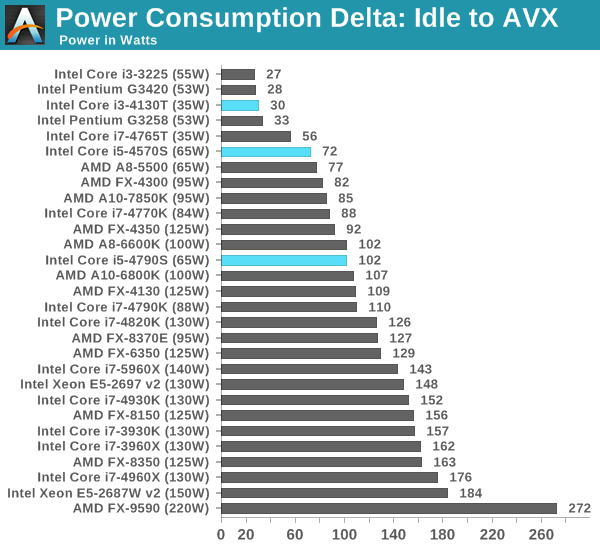
Power consumption for our i3 and i5 samples were near on the mark, whereas the i7-4790S scored 102W from idle to AVX. This is more than the i7-4770K, which might come across as a bit alarming.
We also have some full system power draw numbers from the MSI B85M ECO review, while using a Rosewill Silent Night 500W Platinum power supply. These are still in the 5% power used range for the unit, so efficiency is still around 70-80%.
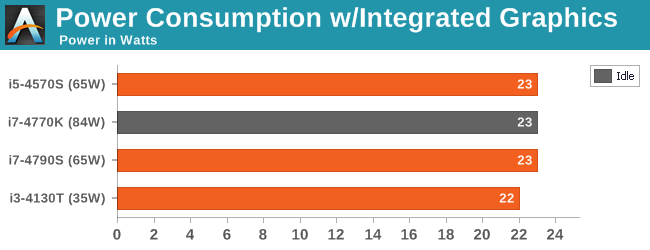
Load Delta Temperature on Intel Stock Cooler
At request from some of our readers on Twitter, we also measured the temperature delta from idle to load on the stock Intel cooler.
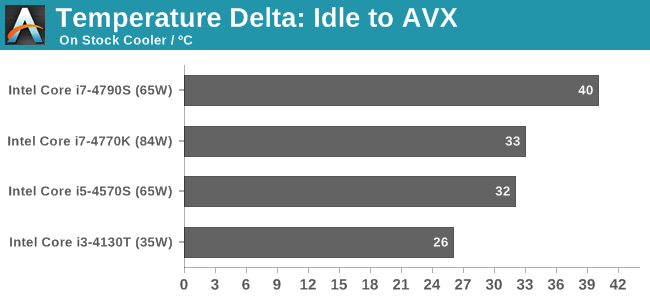



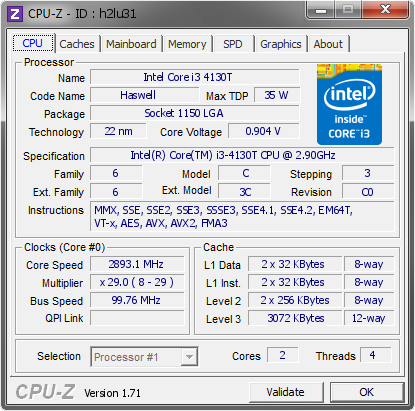








76 Comments
View All Comments
nathanddrews - Thursday, December 11, 2014 - link
Hmph.Khenglish - Thursday, December 11, 2014 - link
So you think these CPUs really are better binned? An undervolted K series cannot always pull off the voltages at the same clocks as a S series?If so do you think these better binned chips finally at least match Ivy Bridge in terms of performance per watt?
casteve - Thursday, December 11, 2014 - link
No, they aren't better binned. Another site looked at the voltage vs. freq curve and found that the std TDP, S, and T parts all followed the same curve. That i7 S part looks like an oddball.Samus - Thursday, December 11, 2014 - link
I work with HP Elitedesk 800's all the time with I5-4570S CPU's. They're incredibly small and quiet, much more so than the identically sized USFF dc7900 Core 2 Duo's they replaced.name99 - Thursday, December 11, 2014 - link
We constantly hear about how aggressively Intel bins parts, how each model is a special snowflake that's exactly optimized for its role, etc etc. I've yet to see any evidence that this is actually true (as opposed to "Intel engages in very aggressive market segmentation --- by product name".The primary reason I'm not convinced is that no-one else bins nearly as aggressively. Apple, never a company to miss the opportunity for a dollar, doesn't engage in some obvious binning (eg ship the iPhone6+ at 100MHz faster; or even give you a 100MHz speed boost in each model as you go from 16GB to 32GB to 64GB storage). Qualcomm offers a fairly limited palette of Snapdragon speeds. Samsung, the master if there ever was one, at slicing and dicing phone models, doesn't offer the same phone at speeds of 1, 1.5, and 2GHz; etc etc.
We have to assume that
- everyone else's processes are crazy uniform compared to Intel OR
- Intel is MUCH smarter than anyone in how they are able to bin OR
- binning (at the micro segmentation Intel offers) just is not a real thing
and the third option seems the most plausible to me.
Samus - Thursday, December 11, 2014 - link
Almost nobody pays attention to GHz numbers in mobile devices. Nobody really cares. And the scaling with ARM really means nothing. Apple consistently has among the highest performance ARM CPU's yet they're lower clocked and lower core count than everyone else. Binning ARM CPU's would require two things in order to be profitable: real-world benefits to a slightly higher clock speed, and marketing the higher clock speed as worth the premium. Currently there are neither. I'd guess 99/100 people don't even know the clock speed of the phone they own, because that's how irrelevant it is. For many applications (such as gaming, where performance is not consistent across the majority of devices) the GPU matters more than the CPU because of how heavily optimized these apps are for the GPU.The PC landscape is totally different.. You still have PC's sold that have 1/10th the performance of a Core i7.
Now, where your idea could be interesting is if they sell an "eco" chip that runs at a lower voltage due to binning. People MIGHT be willing to pay extra for a phone with +20% battery life.
Kjella - Friday, December 12, 2014 - link
Or perhaps the simplest and most obvious explanation - Apple feels they're more in the console game than the PC game. Offer one consistent level of performance across all iPhones of the same generation and that's the spec all developers need to relate to.Hrel - Friday, December 12, 2014 - link
- everyone else's processes are crazy uniform compared to Intel OR- Intel is MUCH smarter than anyone in how they are able to bin OR
Those are both true.
wumpus - Friday, December 12, 2014 - link
So Intel chips can't be overclocked and produce more watts than different lettered processors under identical conditions? That isn't what was tested and would be a rather shocking development.Chips take a considerable time to fab. Markets change fast and somehow Intel manages to produce what the market needs in the face on negligible competition? Yea, I really believe that they are really binning and not simply segementing to what marketing wants.
BSMonitor - Friday, December 12, 2014 - link
Use case. A PC's use case is an entirely different world than mobile phones. Your anti-Apple bias aside, what applications would users engage in on their smart phone where CPU performance could be noticeably segregated by clock speed. In this space. The only indication of CPU performance is the "snapiness" of the response from whatever app you are in.In a PC sense, I could launch an application or task that takes minutes, hours, etc.. 200-300 MHz would be noticeable over the course of an hour of video compression.
Apples and oranges.